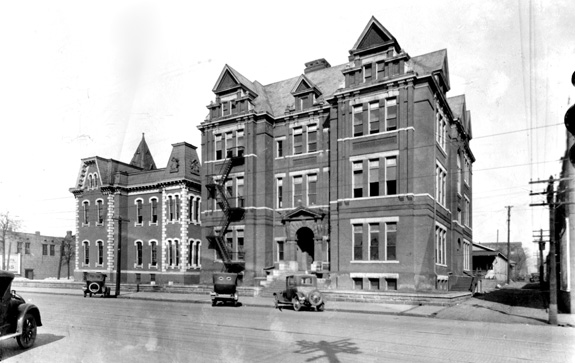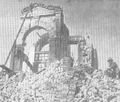Paul Hayne School
The Paul Hayne School, (originally Southside Grammar School, later Paul Hayne Opportunity High School) was a former Birmingham city school located on the northwest corner of Block 173, which is the southeast corner of the intersection of 5th Avenue South and 20th Street, on the present site of the Kirklin Clinic.
The first privately-run Southside Grammar School began operating from a frame building on the same site in the mid-1870s. In 1876 Birmingham City Schools took over operation, converting it into a public grammar school. In 1885–1886 the city rebuilt the school at a cost of $60,000. The building, which opened on March 29, 1886, was three stories tall with a basement, and the upper floor sheltered under a mansard roof. The exterior was clad in light-colored brick with limestone quoins at the corners and segmental arches over the windows. A central entrance tower faced 5th Avenue and was peaked with a tall pyramidal roof spire. The other roofs were of slate with clipped gables and a wrought-iron parapet rail. The new school was named in honor of South Carolina-born poet Paul Hamilton Hayne, who sent an original poem and a book of verse in honor of the school at its dedication.
A major 1889 addition to the south side of the building extended the school along 20th Street. The addition housed 12 classrooms on three stories, with an attic floor enclosed in a multi-gabled roof. The newer building, designed by the firm of Wheelock, Joy & Wheelock and built at a cost of $50,000, was clad in a darker brick and had a more understated ornamental scheme with triple windows and projecting courses.
The expanded Paul Hayne School enrolled 960 students in 1890, making it the largest school in the city. During the 1910s the Birmingham Board of Education connected the building to the municipal steam heat, removing the old oil-burning furnaces from the basement. In 1918 when Central High School burned, some high school classes were relocated to Paul Hayne School. The school continued to serve both elementary and high school students until 1930.
In September 1930 the school was converted from a high school into an "opportunity school" under the direction of R. F. Jarvis. The opportunity school provided vocational instruction to high-school age students with specialized classes in printing, architectural drawing, mechanical drawing, radio, machine shop, pattern making, painting and decorating, commercial art, auto mechanics, electrical work, salesmanship, tea room and cafeteria management and sewing. The students' days were split between practical instruction and academic work related to the trades (shop mathematics, shop science, business English, etc). Evening vocational classes were offered on an individual basis, with a $1 enrollment fee, which was refunded if the student appeared for 90% of sessions. The school's cafeteria was open from 6 to 7 PM. The experiment proved a great success and evening vocational classes were added at several other schools during the Great Depression. In the late 1930s some of those programs were consolidated. After World War II they continued to serve veterans.
In 1952 Paul Hayne School's programs were moved to the newly-opened Glenn Vocational School, a "negro school", at the former Roberts Field in Birmingham's Thomas neighborhood. In 1953 the school was temporarily reopened for Edgewood Elementary School classes displaced by a fire. In March 1954 the board officially approved putting the former Paul Hayne School and Lane Elementary School school up for sale, hoping to get $200,000 from them, to help close an operating deficit of $800,000. The board took no quick action on offers of purchase, but did agree to a proposal from the Mazer Wrecking Company to demolish the structure at no charge in exchange for the opportunity to salvage the brick. Work began, by hand, in December 1954. On March 15, 1955 the school's original cornerstone was removed and a Paul Hayne School time capsule recovered, containing a trove of documents from November 1885.
In August 1958 Woodlawn High School woodworking teacher Paul Cosper was asked to build a model of Paul Hayne School. Working from photographs and a salvaged brick, Cosper built his basswood and aluminum model to a scale of a half inch to the foot. He presented the completed work to Superintendent L. Frazier Banks on October 18. The model was displayed that November in the lobby of the Birmingham Federal Savings & Loan building on the school's former site.
Principals
- N. D. Van Syckel, 1885
- J. B. Cunningham, 1886–1898
- F. L. Bruce, 1898–1899
- Charles Glenn, 1899–1909
- Charles Wardener (junior high), 1909–1910
- Mary Rittenberry (grade school), 1910–1918
- Charles Glenn (acting), 1910–1911
- Clarence Going (acting junior high) 1912–1918
- Clarence Going, 1918–1921
- Chester Bendman, 1921–1923
- N. B. Hendrix, 1923–1926
- T. C. Young, 1926–1930
- R. F. Jarvis, 1930–1938
- Homer Thomas, 1938–1940
- J. Paul Hanlin, 1940–1952
Gallery
References
- Youngblood, Frances (December 6, 1930) "Paul Hayne Opportunity School Passes Experimental Stage And Becomes Success" The Birmingham News - via Birmingham Public Library Digital Collections
- Birmingham Public Schools (1931) Report of Progress, Birmingham Public Schools: September 1, 1921 to August 31, 1931. ibid.
- Teer, Jerry (November 5, 1958) "[http://bplonline.cdmhost.com/digital/collection/p4017coll2/id/14535 Torn-Down School Rebuilt As Model" Birmingham Post-Herald. ibid.
- Summe, Sheryl Spradling. (2001). Homewood: The Life of a City. Homewood, AL: Friends of the Homewood Public Library.




